When in-the-know Atlantans crave the best selection of Korean food, varied and satisfying, they head northeast to the suburbs and the unofficial home of Georgia’s K-Town: Gwinnett County.
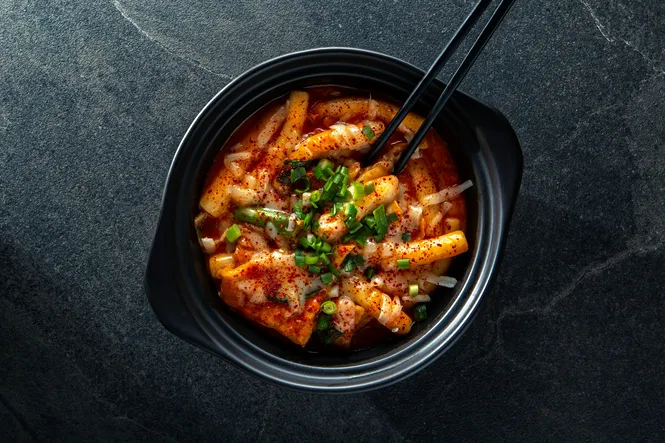
Plenty of locals will tell you about Buford Highway, a concentration of international fare ranging from Bangladeshi to Peruvian, situated just outside Atlanta city limits. But comparatively few know the treasure that awaits if you simply keep driving. Further up Buford Highway (or I-85, if you prefer), where the traffic and housing prices ebb and outlet stores proliferate, is another foodie destination, less fusion, more authentic. If you love Korean food — or have always wanted to try the real deal — this place belongs on your bucket list.
How Gwinnett County Became a Hot Spot for Korean Cuisine
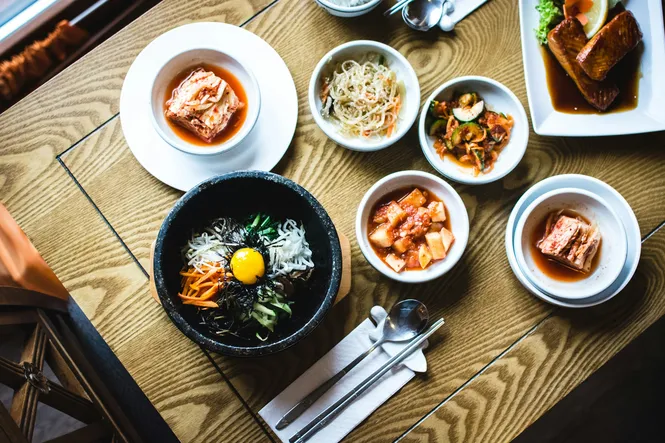
The Korean American Association of Greater Atlanta, now headquartered in Gwinnett County, opened its first office in 1968 off Buford Highway in Doraville, then the hub for the many Korean Americans moving to Georgia. The real estate boom that hit the Gwinnett Place area in the ’90s brought an influx of new businesses, in particular, mega-sized Korean supermarkets, to some of the county’s larger cities like Duluth and Suwanee. Those stores provided the ingredients for early restaurateurs and the comfort food of home for the hundreds of families who eventually settled there.
Andrew Choi, who moved from South Korea to Duluth in 1996, remembers seeing Gwinnett County’s rise as the epicenter of Korean food. The first meal he had on arrival was at a Korean restaurant in Doraville. His family wanted to eat something familiar, he explains. Now, his parents own their own cafe in Duluth.
Though sometimes informally referred to as Korea Town, there’s not one address you can plug into your GPS to get there. Pockets of it flourish around Pleasant Hill Road, Duluth Highway and Lawrenceville-Suwanee Road. Look for a strip mall anchored by a Korean grocery store, and you’re there.
But the Gwinnett Place area, at the junction of I-85 and Pleasant Hill Road, is a convenient place to begin your exploration. While the landmark Gwinnett Place Mall is declining and up for sale — despite its famous appearance in Stranger Things — the Korean community surrounding it is thriving. You’ll find a half dozen Korean markets, including the international H Mart chain and a two-story Mega Mart. Nearly a quarter of the restaurants there specialize in Korean food specifically. You can dine at a different spot each day for a month, plus breakfast, lunch and dinner on weekends, and still have more to sample.
A native of Seoul who now calls Duluth home, Sarah Park describes the area as “vibrant,” full of conversation, commerce and, yes, loads of food.
“I love how the Korean culinary scene here has so much variety,” she says. “Fried chicken joints, comfort food restaurants, homestyle cooking, fusion cuisine with other Asian cuisines, bakeries and cafes, snack places, buffets and small catering businesses — you name it, you can find it here. Everything is made from scratch. You can walk into a Korean restaurant and immediately smell food balanced with harmonious seasoning and lots of deep, rich broth that gives warmth.”
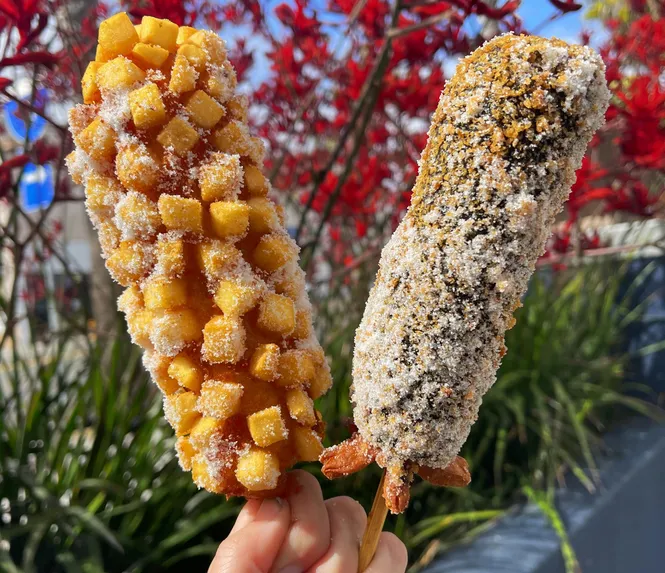
It’s the warmth that envelops you when you step inside one of the myriad eateries cooking up favorites like sundubu-jjigae, soft tofu stew, and gamjatang, spicy pork bone soup. Korean street food, meanwhile, is less about hearth and home and more about indulging on the go. Case in point is myungrang, a rice flour battered and fried hot dog on a stick, clustered with potatoes, rolled in sugar crystals or infused with squid ink, depending on your preference. You can pick up one, or more likely three, in the back corner of Duluth’s Super H Mart at the counter service restaurant appropriately named Myungrang Hot Dog.
Then there’s cafe culture, every bit as serious as any patisserie in France. Koreans often retire to a cafe for sweets or coffee after dinner, explains Choi, who worked on Cafe Rothem’s menu development when it opened in 2016. He helped create their signature item, the “watteok,” a mix between a Belgian waffle and the pancake-style Korean street snack, hotteok. When you cut into the center, cinnamon and sugar ooze out, to the delight of Instagrammers. But the watteok is rather the exception when it comes to sweetness. Most of the area’s Korean bakeries feature subtler flavors like green tea, sweet potato and egg custard. Even patbingsu, a popular after-supper treat constituting a mountain of shaved ice topped with fruit, syrups, candies and more, isn’t overly decadent, the first ingredient, after all, being ice. Tree Story Bakery & Cafe serves a traditional version decked out with red beans, mochi, cereal, condensed milk and mixed grain powder.
While not everyone likes the red beans — I still don’t — the bakery attracts a diverse clientele. Like other restaurants on the local Korean dining scene, it initially grew with the support of local Koreans. But you’ll see a range of folks there today: students enjoying free Wi-Fi, families sipping drinks, out-of-towners gawking at the rows of elaborate pastries. More than a few are snapping photos before eating, the desire to somehow preserve all that beauty being one that crosses cultures.
How To Choose a Korean Eatery
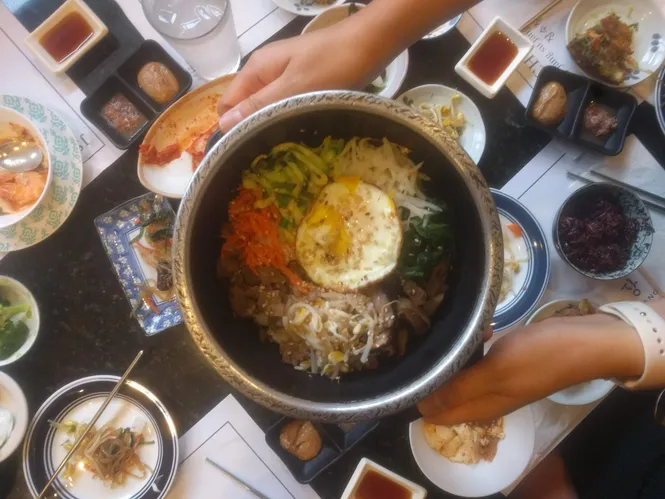
Choosing one place to eat among the many is a challenge. An early arrival to the culinary scene, Jang Su Jang is something of a safe bet, the sort of place the local visitors center recommends to tourists. Opened in 2005, the restaurant specializes in homestyle Korean cuisine. A visit there involves a dizzying procession of dishes, eight of which are sides, or banchan, intended to complement the flavor of the main course. The servers are friendly, happy to tell you what each dish is and how to eat it — how to soak the rice in seolleongtang soup, how the cabbage leaves for bossam jungsik should fold around the steamed pork, jalapeños and sliced radishes to make a wrap.
Traditionally, the dishes would be shared among the family, says second-generation owner Stephen Cho. Most patrons today order their own entree, but if you’re eating with friends, it’s hard not to let your fork stray to someone else’s plate, drawn by the unusual flavors and scents, the color and quantity of dishes.
“A lot of people think Korean food is just Korean barbecue nowadays,” says Cho. “Our family wants to keep this traditional style of Korean dishes.”
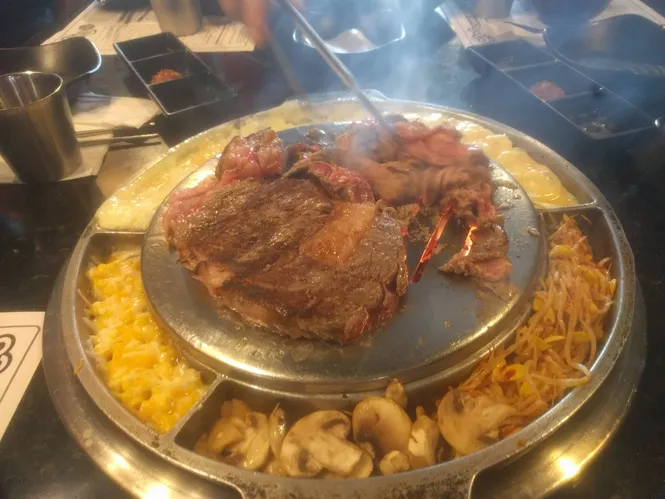
That’s not to knock Korean barbecue, something of a gateway dish for aspiring foodies into the world of Korean cuisine. And it’s everywhere in K-Town: K-BBQ Factory, Mapo Korean BBQ, Honey Pig Atlanta, 9292 Korean BBQ. And those are just the ones right by the Gwinnett Place Mall. You might think that makes it easier to try a handful of them on a weekend trip. Don’t be fooled. Each could stand alone as a meal to last a day.
Wherever you go, it’s the typical Korean barbecue setup: thin slices of marinated and raw beef and pork, which you cook in an open grill at the center of the table. Side dishes, called banchan, arrive in quick succession. You’re welcome to ask for free refills of those, but if you’ve opted for all-you-can-eat, you don’t want to fill up on sides.
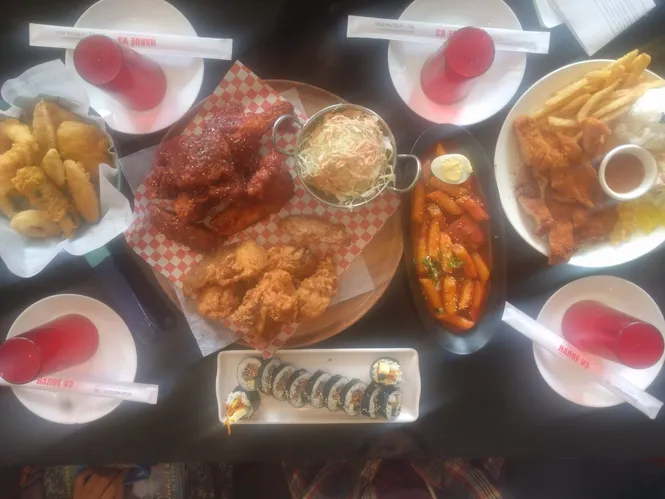
Park recommends choosing the combo option rather than à la carte or unlimited. “The beauty of it is there’s so many different portions of the meat that you can try,” she says. Or go for the most different of them all — intestines barbecue. It’s the house specialty at Gop Chang on Fire. The taste is hard to pinpoint: rich, umami. Even if you don’t like it, you’re guaranteed to make a memory … “that time I ate intestines in Georgia.”
Korean fried chicken is another must when you’re here. Like barbecue, this classic dish has become almost ubiquitous across America. In some ways, it’s the same everywhere, pleasantly predictable. In other ways, each restaurant takes a different spin on it. With a casual lunch counter vibe and chicken piled high on wooden plates, Harue offers a no-fuss approach. It’s good food at fair prices. Or as their mantra emblazoned on the back wall calls it: “tasty and affordable food to enjoy with family and friends.” Beyond fried chicken, they serve odeng, fish cakes; gimbap, bite-sized seaweed-wrapped rice rolls; and tteok-bokki, chewy, oblong rice cakes coated in a pepper paste. It’s the perfect spot for lunch and right next-door to Cafe Rothem when you’re ready for dessert.
Where To Eat the Best Korean Food in Gwinnett County
“Best” is certainly a relative term, but there are a few places you definitely don’t want to miss while you’re in the area. Here’s a quick roundup of must-try Korean spots in Gwinnett County.
Myungrang Hot Dog
Shopping the fresh seafood, exotic snacks and vast selection of produce inside the Super H Mart can work up an appetite. Head to the back of the store near the home goods section for a myungrang, the Korean version of a corn dog. No corn here, but squid ink, sugar and deep-fried potatoes are optional add-ons for your dog. Or get a dog that’s simply filled with mozzarella cheese.
Cafe Rothem
With most of the local Korean restaurants steering away from fusion, Cafe Rothem isn’t afraid to blur the lines. Their “watteok” is a prime example, part Belgian waffle, part Korean pancake. The cafe smells of hazelnuts when you enter. Linger over a cup of misu latte, catch an open mic night, or join their book club (books in Korean and English line the walls).
Tree Story Bakery & Cafe

Part of the Park Village Shopping Center, where you’ll also find an H Mart and several Korean restaurants, Tree Story Bakery & Cafe is a wonderland for pastry lovers. Baskets of individually packaged sweet and savory breads fill the shelves and tables near the entrance. More complex desserts like cakes and mousses line glass cases at the counter. Park says she enjoys their Misugaru drink for a quick meal. It’s thick and undoubtedly wholesome. Those with a sweet tooth may prefer the patbingsu, which ranges from chocolatey tiramisu to traditional with red beans.
Jang Su Jang
This landmark Korean restaurant focuses on traditional dishes like tofu soup and dumplings, each with plenty of banchan alongside to heighten the experience. The menu can be daunting with so many options. Order a family-style special, assuming you have someone you can split with or don’t mind the leftovers, and you’re guaranteed a delicious dinner.
Gop Chang on Fire
Suwanee is only 10 minutes farther up the road from Duluth, where Seoul of the South hosts its tour and most Korean restaurants are located. It’s worth the drive to try Gop Chang on Fire. If you can get past the shape of the specialty dish at this barbecue restaurant, you can revel in a truly authentic Korean experience: grilling offal, particularly intestines, or gobchang, on a tray over hot coals in the center of the table. As always, it’s surrounded by banchan that keep on coming as long as you want.
Harue
When you need KFC — Korean fried chicken — Harue delivers. You’ll be lucky to get a table during their lunchtime rush, but grab one if you can and order a generous selection of squid and potato tempura and their popular tteok-bokki, which has all the heartiness of a pasta dish. You won’t leave hungry.
Cultural Notes
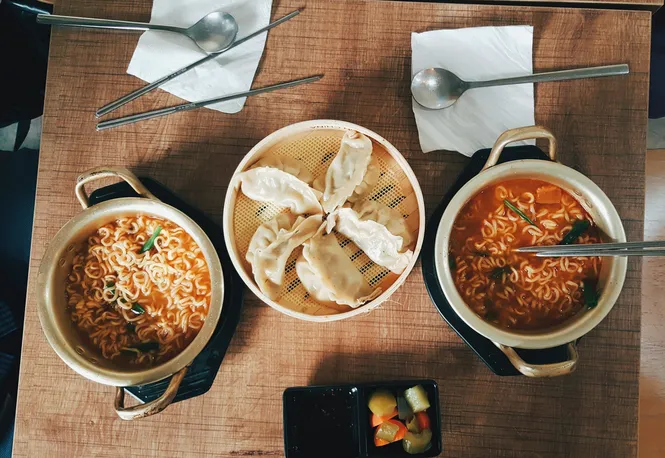
With so much selection, it’s easy to get caught up in the flavors alone, but K-Town engages all five senses. It’s the full experience: TVs streaming K-pop while you eat, piles of striped chamwae melons in the markets, snatches of Korean conversation. This isn’t the kind of place you want to rush through. Take your time. Browse the comics, manhwa, at World of Life Books. Party at a Korean karaoke bar. Relax at a 24/7 Korean sauna.
And for those on tighter schedules? As you might expect, this culinary enclave has its own food tour, but less expected is the generous helping of cultural highlights included. Launched in 2015, Seoul of the South covers four restaurants in as many hours. They try to hit a variety: Korean barbecue, fried chicken, something traditional, something sweet. There are only a handful of tours during the summer, all of which fill up well in advance.
Park, who works as the confidential executive assistant to Gwinnett County’s commissioner in District One during the week, leads the Saturday outings, dispensing bits of Korean history, dining tips and more from the front of the trolley. She teaches fragments of Korean and warns everyone, “Pace yourselves.” It’s a lot of food. Everyone digs in around communal tables, an appropriately Korean approach to mealtime.
While no one quite masters Korean on the tour — though some fare better than others at using chopsticks — Park says it’s important to her to share Korean culture and Korean food.
“Nothing really bridges cultures better than sharing a meal and experiencing the foods that bring comfort to others,” she explains. “It is through this shared experience that we can truly find what binds us together.”
Choi agrees. He calls it “the shared identity around Korean food.” After all, it’s what generations have grown up with, passed down in recipes and used as the focal point for life’s celebrations and everyday family gatherings. There’s a part of all that when you’re dining at a Korean restaurant, whether in Duluth or Seoul.
“Growing up, sharing food items for dinner with multiple neighbors was a common practice, and as children, we were the ones delivering food to the different households,” Choi recalls. “Korean restaurants help me to relive some of that experience by bringing friends and family to enjoy all of the food together. When I take people who are not familiar with or crave Korean food because they do not usually try it, it’s like bringing them to my house or hometown to share in the experience.”



